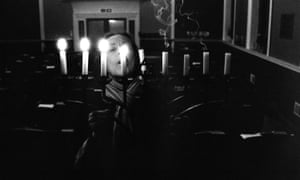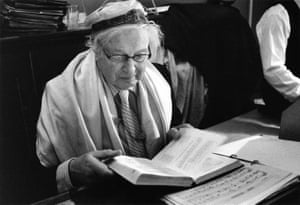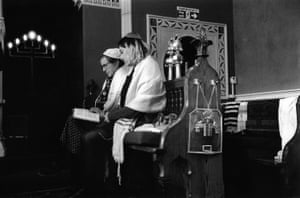Capturing the Kehillah on Camera
Categories: Jewish Heritage Walks
Reproduced from The Guardian, 8.9.19
Say a prayer: the Muslim woman who photographed Bradford’s last synagogue
Nudrat Afza, a single mother who can’t afford her own camera, talks us through her new show – of poignant shots capturing the last 45 Jewish worshippers in the city’s only remaining synagogue

The last UK census, which took place in 2011, found that there were just 299 Jews left in Bradford, a tiny number for a city that became home to so many German Jews in the 19th century that the warehouse district they created is still called Little Germany. The Muslim population, meanwhile, hit 129,041 the same year.
The city’s synagogue, a grade II-listed building, almost shut down in 2013, unable to afford roof repairs – until the Muslim community raised funds to cover costs. A £103,000 lottery grant followed, enabling full repairs, but the number of worshippers has stuck stubbornly at just 45 – with occasional newcomers balancing out the deaths of elderly worshippers.
All of this caught the attention of Nudrat Afza, a Muslim single mother who – despite never being able to afford her own camera – is about to exhibit a series of photographs documenting the dwindling population of Bradford’s last remaining synagogue. Afza, who came to the UK from Pakistan as a teenager in the late 1960s, made friends with Rudi Leavor, the synagogue’s “93-and-a-quarter-year-old” chairman, after carrying out a particularly heroic mission to transfer a fridge from a synagogue in nearby Shipley when it closed in 2013. Leavor arrived in Bradford as a refugee in 1937, part of the second wave of German Jews fleeing the Nazis.

Non-Jews are welcome to attend services, says Leavor, as this is a modern reform synagogue. “They can sing along and so forth, but they can’t take part actively – for example, when we carry the Torah around the synagogue, they can’t do that. And they can’t read prayers from the altar. But we welcome anyone to come and join us.”
Built in 1880 in an unusual Moorish style, the place of worship had its second heyday after the second world war. “On the high holy days,” says Leavor, “the synagogue was so full we had to put extra seats in the aisles. But over time, people started moving away, often to London or, like my own four children, married out of the faith. In my cynical opinion, if we didn’t have such a beautiful building, the Jewish community in Bradford would already have gone elsewhere, but we have become a focal point that people like to visit.”
Two years ago, Afza embarked on her project to photograph what felt like the synagogue’s final chapter, wondering how long it would last. “There are fewer and fewer Jewish people left,” she says. “It’s this declining population and disappearing culture that I wanted to document.”
The photographs, all black and white, capture a mixture of the modern and the traditional: an electric menora illuminates two women as they read a prayer book, one with dip-dyed hair; a young woman in a leather jacket looks on as a bald man in kippah and prayer shawl bows his head. Slightly grainy, they convey with intimate tenderness a community Afza has come to know and treasure as much as her own.
The rabbi refused her request to take pictures during services, unless she used a telephoto lens, which she could not afford, so they let her take pictures before and after. Afza has never been able to afford a camera since becoming a full-time carer for her disabled daughter 31 years ago, relying instead on borrowed equipment and grants. Her exhibition, Kehillah, which can mean congregation or community in Hebrew, is supported by Arts Council England.

Photographing inside the dimly lit synagogue posed particular challenges, even with top-of-the-range cameras, including a medium-format Bronica and an XPan Hasselblad given to her on permanent loan by Simon Beaufoy, the Oscar-winning screenwriter behind The Full Monty and Slumdog Millionaire. Beaufoy became a fan after seeing Afza’s exhibition about the female supporters of Bradford City football club and insists the camera is hers to keep, though she won’t accept it.
“Everyone with a phone can take a photograph,” says Beaufoy. “But not everybody is a photographer. In the colourful noise of a billion images, a few people stand out. Nudrat is one of them. Like all the best art, the images reflect the artist: watchful, politely enquiring, melancholic with the hint of a smile.”
Afza has never had a lesson and doesn’t work digitally, not having access to email or the internet. But she has always loved photography, particularly the work of Henri Cartier-Bresson and the war photographer Don McCullin, who has himself documented Bradford’s Muslim community. She has now been made an honorary member of the synagogue and continues to be a regular visitor. “I think she has more to do with us,” says Leavor, “than with her own mosque.”
• Kehillah is at the Boardrooms, Salts Mill, Saltaire, 13-22 September.
Download as PDF below

Comments are closed.